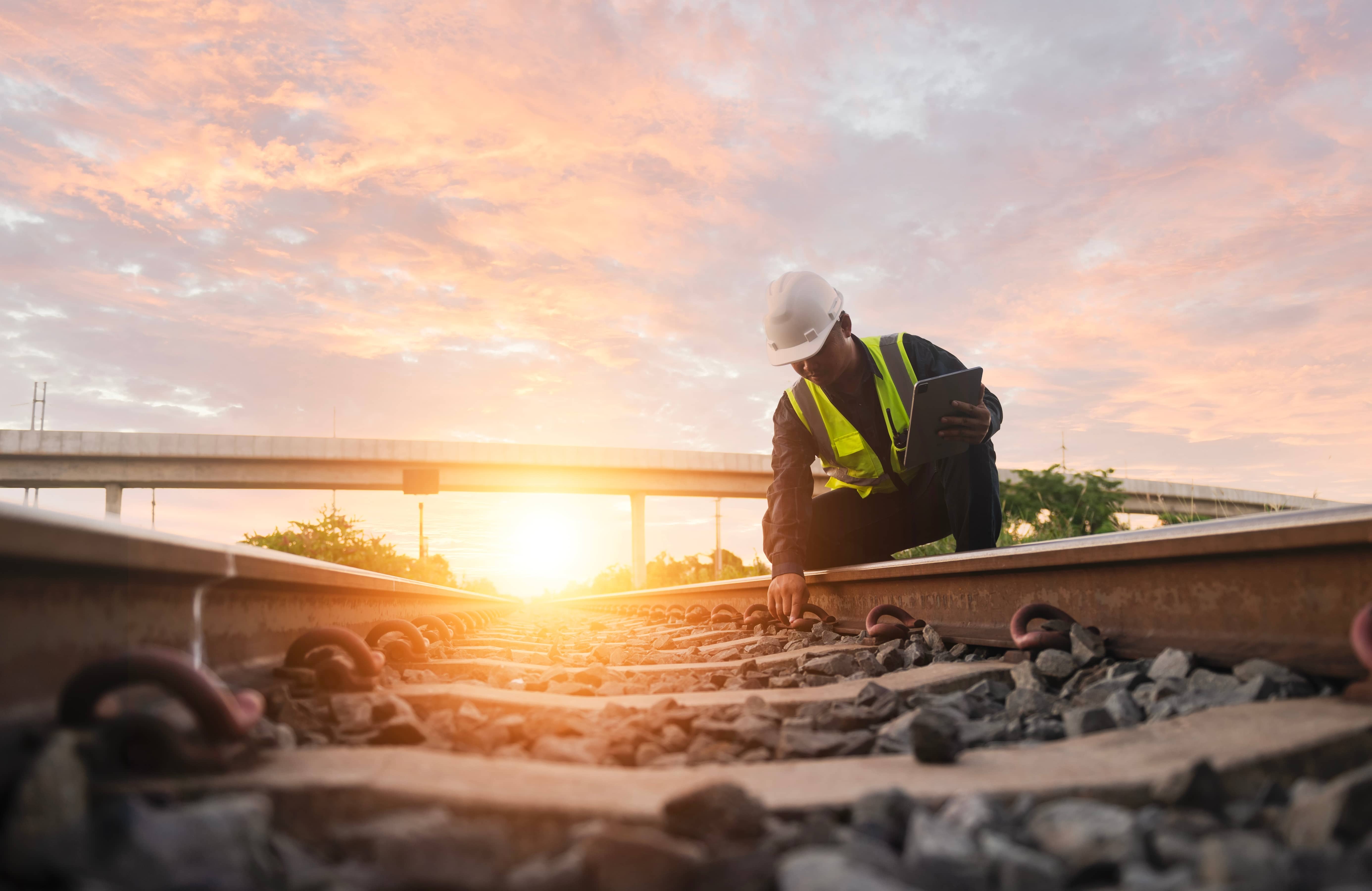Trains have a longer history than you might expect. As far back as the 1550s, German ore miners used horses to haul "wagons" on wooden rails to speed up the delivery of goods.
By the 1700s, iron rails replaced wood to make the tracks more stable, paving the way for modern train systems. However, it was British railway pioneers who truly advanced this technology. Innovators such as George Stephenson were instrumental in shaping the railways we know today.
Who were the pioneers of the railway?

The railway revolution was a product of British ingenuity during the Industrial Revolution. The engineering behind steam locomotives didn’t happen overnight - it took a series of individuals to make it possible. Six pioneers in particular stand out for their contribution to the railway industry. Together, they have transformed transport forever.
Richard Trevithick (1771 - 1833)
British mining engineer, Richard Trevithick, built the world’s first steam locomotive in 1804. Although it was neither particularly powerful nor efficient compared to later models, it marked the beginning of the railway age by proving that steam power could be used for rail transport. As a result, Trevithick is often considered the inventor of trains.
Trevithick continued to refine his designs, and in 1808, his ‘Catch Me Who Can’, became the first locomotive to carry paying passengers.
George Stephenson (1781 - 1848)
Known as the "father of the railways," George Stephenson played a pivotal role in developing Britain’s early railway network.
In 1825, Stephenson created the 26-mile long Stockton & Darlington Railway, the world's first public railway. On these lines, trains carried coal from collieries in County Durham to trade routes leading to London.
He later designed the world’s first intercity railway, the Liverpool & Manchester Railway, in 1830. The line featured technological marvels, such as the Wapping Tunnel and the Sankey Viaduct.
Robert Stephenson (1803-1859)
Following in his father’s footsteps, Robert Stephenson played a key role in expanding Britain’s railway network.
In 1833, Robert engineered the 112-mile-long London & Birmingham Railway, the first line to connect London with major industrial cities. Passengers could now get from London to locations such as Birmingham, Liverpool, and Manchester.
Stephenson is perhaps best known for his Rocket, which won the Rainhill Trials in 1829 and proved that locomotives could be both fast and efficient. The design of the Rocket's efficient boiler design set the standard for locomotive engineering for over a century.
For those interested in learning about Stephenson's family legacy, the Stephenson Railway Museum offers a wealth of information.
Isambard Kingdom Brunel (1806 - 1859)
An engineering visionary, Isambard Kingdom Brunel was renowned for his ambitious projects. Engineering ran in his family, as his father Marc Isambard Brunel, pioneered the Thames Tunnel, which opened in 1843.
Isambard himself was the mastermind behind the Great Western Railway, a marvel of its age. The line features structures that still impress to this day, such as the Wharncliffe Viaduct and Maidenhead Bridge.
Daniel Gooch (1861 - 1889)
Another key figure in the success of the Great Western Railway was Daniel Gooch, who served as the Superintendent of Locomotive Engines. He designed locomotives such as the Firefly and Iron Duke. Later, he became Great Western Railway’s chairman. Here he oversaw expansion projects such as the technically challenging Severn Tunnel, linking Monmouthshire and South Gloucestershire.
Joseph Locke (1805 - 1860)
Joseph Locke’s approach to building railways challenged the belief that trains could handle steeper gradients. His work on the Lancaster & Carlisle Railway proved otherwise, and his vision was responsible for much of the groundwork for today's West Coast Mainline.
Locke also contributed to the Caledonian and the Grand Junction Railways, working closely with George and Robert Stephenson.
Significant moments in railway history

The development of the UK rail network required investment, innovation, and determination. There were a number of historic moments that helped define railway history.
Brunel vs. the Stephensons
The ‘Battle of the Gauges’ was a heated debate in the early days of railway construction, centered on the optimal distance between rails. Isambard Kingdom Brunel believed that a ‘broad gauge’ (seven feet and one-and-a-quarter inches) offered better stability and speed. Meanwhile, George and Robert Stephenson supported a narrower gauge of four feet and eight-and-a-half inches, arguing that it was more cost-effective and practical.
While it may seem trivial, this decision had major implications. Without standardisation, passengers would have to swap between trains frequently to get to where they wanted. After a series of government inquries, Parliament passed The Gauge Act in 1846, which standardised rail gauges to be four feet and eight-and-a-half-inches. The Stephensons had won.
The Race to the North
In the late 19th century, railway operators competed to offer the fastest journey times to northern England. This ‘Race to the North’ saw Great Northern Railway and the North Eastern Railway go head-to-head. The GNR won thanks to its Stirling Single locomotives, which had eight-foot driving wheels and took trains beyond 60mph between engine changes.
Not only was this race fascinating for passengers, it also fueled investments in faster trains and improved track design.
The world's first road-rail bridge
The High Level Bridge in Newcastle, completed in 1849, is an excellent example of early railway engineering and was the first combined road and rail bridge.
Stretching 1,338ft (408 metres), the bridge's innovative design featured a road deck beneath the railway tracks. Engineers built the bridge with new tools such as Nasmyth Steam Pile Driver which accelerated foundation construction.
The bridge remains a vital part of Newcastle’s infrastructure, complemented by the nearby Queen Elizabeth Bridge for the Metro system.
Modern railway pioneers

Modern pioneers have continued to push the boundaries of the railway industry to improve safety, efficiency and passenger experience.
Hideo Shima (1901 – 1998)
Hideo Shima played a huge role in creating Japan’s high-speed rail system with the creation of the Shinkansen or Bullet train. After the tragic 1947 Hachikō Line derailment, which killed 184 people, Shima advocated for safer steel-built passenger carriages.
In 1955, he led the Shinkansen project, overcoming huge engineering challenges to launch the first high-speed rail in 1964.
Hideo resigned before the project’s completion, however, in his home country, he's generally regarded as the "father of the Shinkansen." His designs and ideas have helped shape high-speed trains worldwide, particularly in France, Spain, and China.
Andy Byford (1965 – Present)
British-born Andy Byford earned his reputation by turning around public transport systems across the globe. From improving services on the Tube to modernising Toronto Transit Commission, Byford has led major transformation projects. He later oversaw Crossrail’s completion as Transport for London’s Commissioner and now contributes to Amtrak’s high-speed rail development in the United States.
Mark Carne (1959 – Present)
Mark Carne introduced major improvements as chief executive of Network Rail (2014-2018) despite budget constraints. He raised funds through property sales, helping to redevelop key stations such as Reading and Birmingham New Street. Carne also played a key role in the reopening of the Borders Railway, as well as overseeing the Digital Railway strategy to boat capacity and safety.
The lasting legacy of Railway Pioneers
From the early wooden tracks to the high-speed rail systems of today, railway pioneers have continuously shaped the way people and goods travel. These visionaries have revolutionised rail transport, overcoming engineering challenges and setting new standards for efficiency and safety. Their innovations have laid the foundations for our modern rail network which continues to evolve with new advancements, technology and infrastructure.














